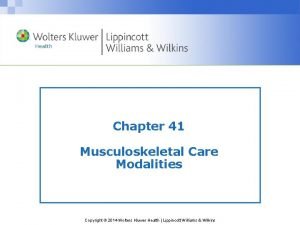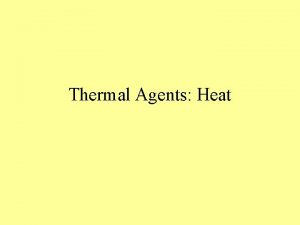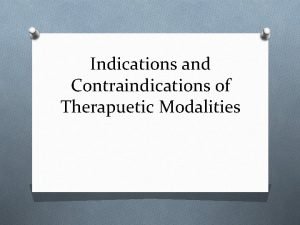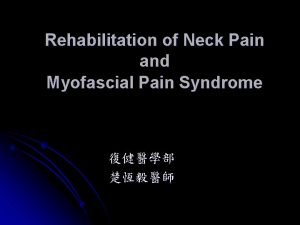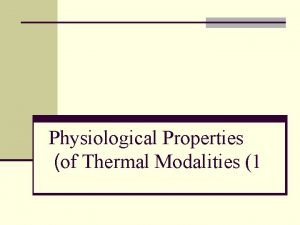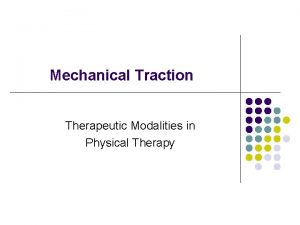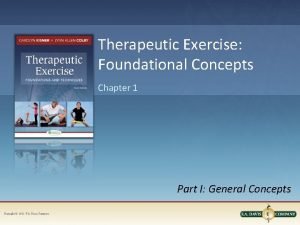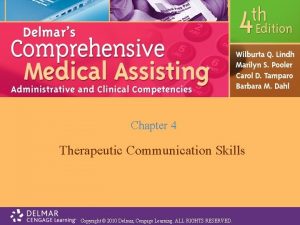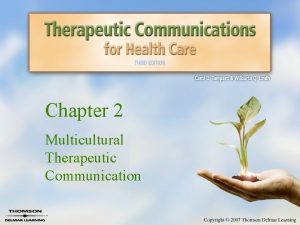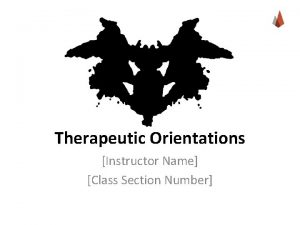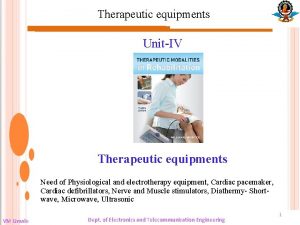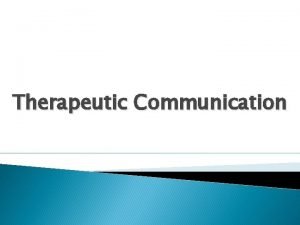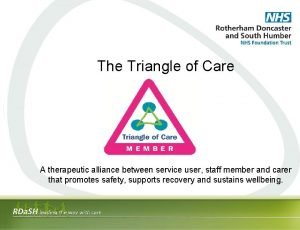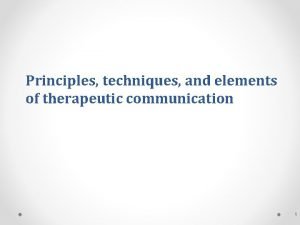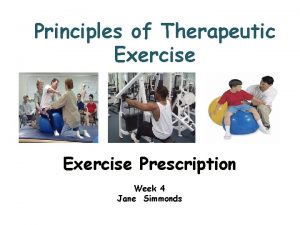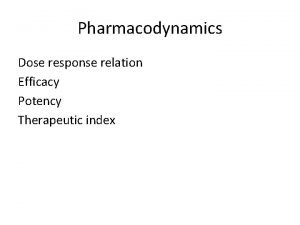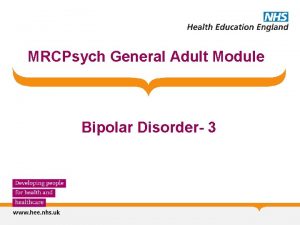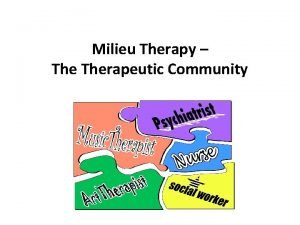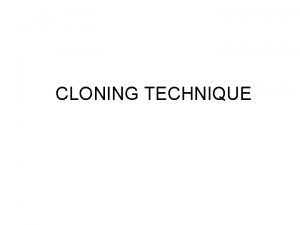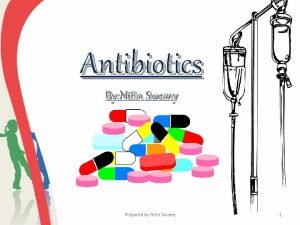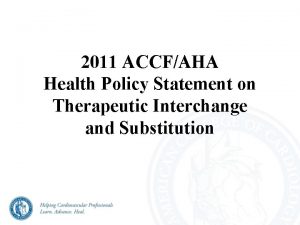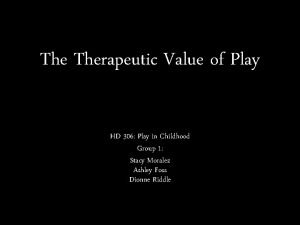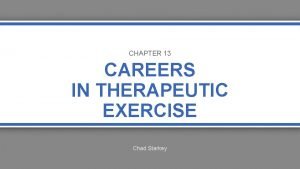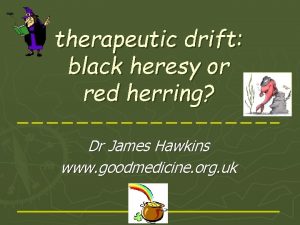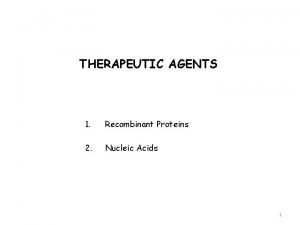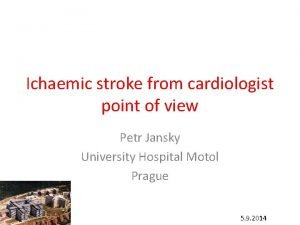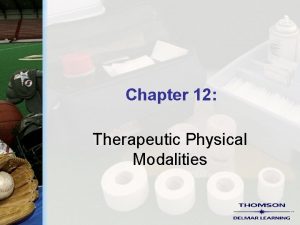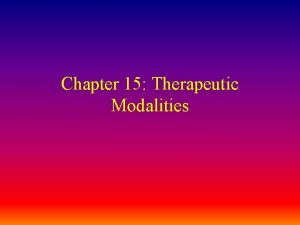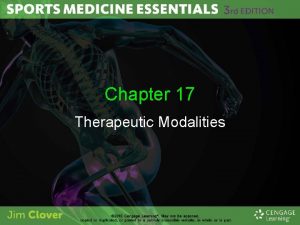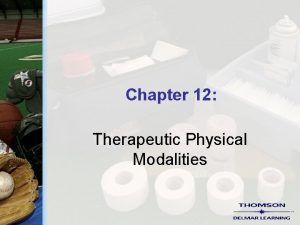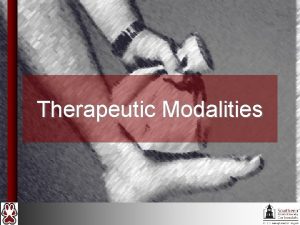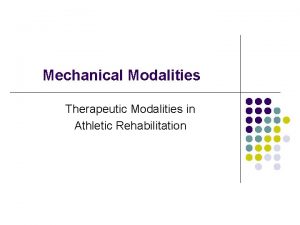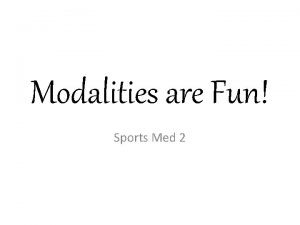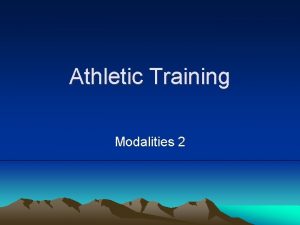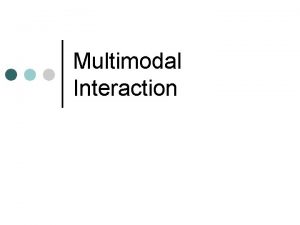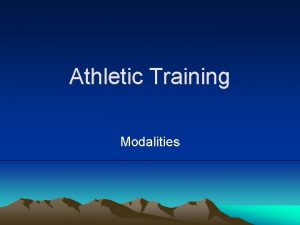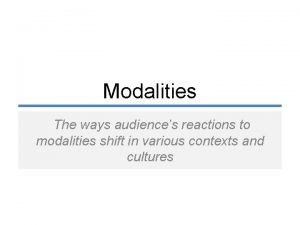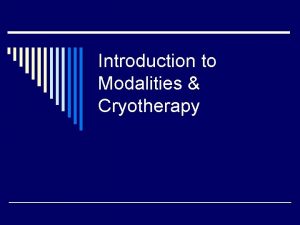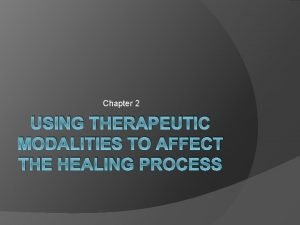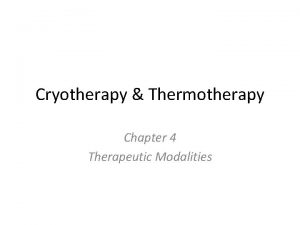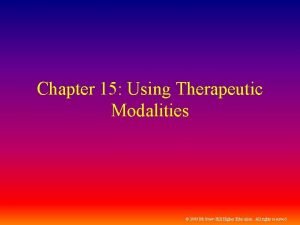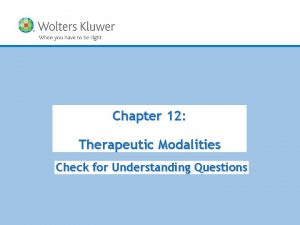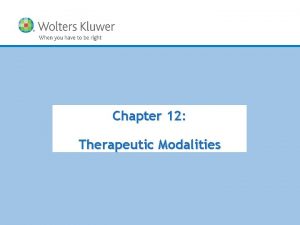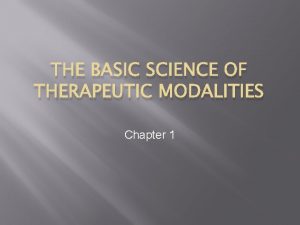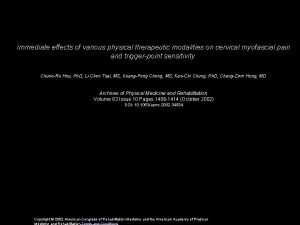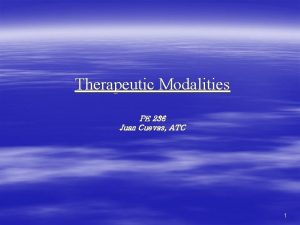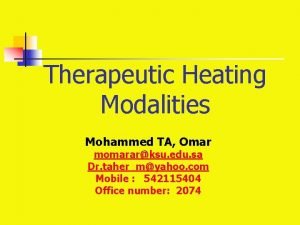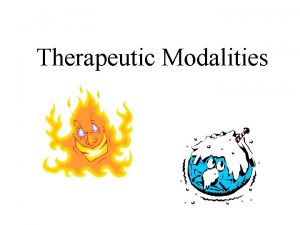Chapter 15 Therapeutic Modalities Therapeutic Modalities n In







































- Slides: 39

Chapter 15: Therapeutic Modalities

Therapeutic Modalities n In any rehabilitation program, modalities should be used primarily as adjuncts to therapeutic exercise and certainly not at the exclusion of range-of-motion or strengthening exercise.

Cryotherapy n Application of cold; the major therapeutic value of cold is its ability to produce anesthesia, allowing pain-free exercise. Cold as a therapeutic agent is a type of electromagnetic energy classified as infrared radiation. Wet ice is a more effective coolant because of the extent of internal energy needed to melt the ice.

Heating Response n Causes a slight temperature increase during cooling. The extent of cooling depends on the thickness of the subcutaneous fat layer.

Physiological Variables of Crotherapy n n n n Variable Response to Therapy Muscle spasm Decreases Pain perception Decreases Blood flow Decreases Metabolic rate Decreases Collagen elasticity Decreases Joint stiffness Increases Capillary permeability Decrease Edema Controversial

Cryotherapeutic Methods n n n n Ice Massage Duration: 10 to 15 minutes Indications: small muscle areas subacute injury subacute inflammation muscle strain Contusions acute pain chronic pain n n n Contraindications pressure contraindications suspected fractures uncovered open wounds circulatory insufficiency cold allergy cold hypersensitivity anesthstized skin

Cryotherapeutic Methods n n n n Cold or Ice Water Immersion Duration: 10 to 20 minutes Temp: 50°F to 60ºF Indications: Distal body parts Acute injury Acute inflammation Acute pain Chronic pain post-surgical pain Post-surgical edema n n n n Contraindications Cardiac involvement Respiratory involvement Uncovered open wounds Circulatory insufficiency Cold allergy Cold hypersensitivity Anesthetized skin

Cryotherapeutic Methods n n n n Ice Packs (Bags) Duration: 10 -20 minutes Indications: Acute injury Acute inflammation Acute pain Chronic pain Post-surgical edema n n n n Contraindications Cardiac involvement Respiratory involvement Uncovered open wounds Circulatory insufficiency Cold allergy Cold hypersensitivity Anesthetized skin

Cryotherapeutic Methods n n n n Cold Whirlpool Duration: 5 to 30 minutes Temp: 50°F to 60°F Indications: Subacute inflammation Chronic inflammation Peripheral vascular disease Peripheral nerve injuries Distal body parts n n n Contraindications Acute problems to turbulence Acute problems to gravity Requiring postural support Skin conditions Cardiac involvement Respiratory involvement Uncovered open wounds Circulatory insufficiency Cold allergy Cold hypersensitivity Anesthetized skin

Cryotherapeutic Methods Cryokinetics n Combines cryotherapy with exercise

Thermotherapy n Application of heat; Heat has the capacity to increase the extensibility of collagen tissue.

Physiological Variables of Thermotherapy n n n n Variable Response to Therapy Muscle spasm Decreases Pain perception Decreases Blood flow Increase Metabolic rate Increase Collagen elasticity Increase Joint stiffness Decrease Capillary permeability Increase Edema Increase

Comparing the Physiological Variables of Crotherapy and Thermotherapy n n n n Variable Muscle spasm Pain perception Blood flow Metabolic rate Collagen elasticity Joint stiffness Capillary permeability Edema Response to Cryotherapy Decreases Decreases Increases Decreased Controversial Response to Thermotherapy Decreases Increases Decreased Increases

Thermotherapy n n n Special Considerations in the Use of Superficial Heat Never apply heat when there is a loss of sensation Never apply heat immediately after an injury Never apply heat when there is decreased arterial circulation Never apply heat directly to the eyes or genitals Never heat the abdomen during pregnancy Never apply heat to a body part that exhibits signs of acute inflammation

Thermotherapy Superficial tissue is a poor thermal conductor n temperature rises quickly on the skin surface as compared with the underlying tissues n There are limitations of superficial tissue n The deeper tissues, including the musculature, are not significantly heated because the heat transfer from the skin surface into deeper tissues is inhibited by the subcutaneous fat, which acts as a thermal insulator, and by the increased skin flow, which cools and carries away the heat externally applied. n

Thermotherapeutic Methods n n n Moist Heat Packs (Hot Packs) Duration: 15 -20 minutes Indications: Subacute inflammation Chronic inflammation Reduction of subacute pain Reduction of chronic pain Subacute muscle spasm Chronic spasm Decreased range of motion Hematoma resolution Reduction of joint contractures Infection n n Contraindications Acute conditions Peripheral vascular disease Impaired circulation Poor thermal regulation

Thermotherapeutic Methods n n n n Hot Whirlpool Duration: 5 to 30 minutes Temp: 96°F to 104°F Indications: Subacute inflammation Chronic inflammation Peripheral vascular disease Peripheral nerve injuries Distal body parts n n n Contraindications Acute problems to turbulence Acute problems to gravity Fever Requiring postural support skin conditions

Hydrotherapy Methods n n n n Contrast Bath Duration: 20 to 30 minutes Temp: 50°F to 60°F: 96°F to 104°F Indications: Ecchymosis removal Edema removal Subacute inflammation Chronic inflammation Impaired circulation n n Contraindications Acute injuries Cold hypersensitivity Whirlpool contraindications Cold application contrindications Hot application contrindications

Hydrotherapy Methods n n n n Cold Whirlpool Duration: 5 to 30 minutes Temp: 50°F to 60°F Indications: Subacute inflammation Chronic inflammation Peripheral vascular disease Peripheral nerve injuries Distal body parts n n n Contraindications Acute problems to turbulence Acute problems to gravity Requiring postural support Skin conditions Cardiac involvement Respiratory involvement Uncovered open wounds Circulatory insufficiency Cold allergy Cold hypersensitivity Anesthetized skin

Hydrotherapy Methods n n n n Hot Whirlpool Duration: 5 to 30 minutes Temp: 96°F to 104°F Indications: Subacute inflammation Chronic inflammation Peripheral vascular disease Peripheral nerve injuries Distal body parts n n n Contraindications Acute problems to turbulence Acute problems to gravity Fever Requiring postural support skin conditions

Acoustic Therapy: Ultrasound Indications n n n n Acute and post acute conditions (non-thermal) Soft tissue healing and repair Scar tissue Joint contracture Chronic inflammation Increased extensibility of collagen Reduction of muscle spasm Pain modulation n n n n Increase blood flow Soft tissue repair Increase in protein synthesis Tissue regeneration Bone healing Repair of non-union fractures Inflammation of myositis ossificans Plantar warts Myofascial trigger points

Acoustic Therapy: Ultrasound Contraindications n n n n Acute and post acute conditions (thermal) Areas of decreased temperature sensation Areas of decreased circulation Vascular insufficiency Thrombophlebitis Eyes Reproductive organs n n n n Pelvis immediately following menses Pregnancy Pacemaker Malignancy Epiphyseal areas in young children Total joint replacement Infection

Electrotherapy: Electrical Stimulation n Electricity is a form of energy that displays magnetic, chemical, mechanical, and thermal effects on tissue. n It implies a flow of electrons between two points.

Electrotherapy: Electrical Stimulation All therapeutic electrical generators are transcutaneous electrical stimulators. n The majority of these generators are used to stimulate peripheral nerves and are correctly called transcutaneous electrical nerve stimulators (TENS). n Occassionally the terms neuromuscular electrical stimulator (NMES) or electrical muscle stimulator (EMS) are used; however, these terms are only appropriate when the electrical current is being used to stimulate muscle directly, as would be the case with denervated muscle in which peripheral nerves are not functioning. n

Electrotherapy: Electrical Stimulation Direct Current (DC current) n Flows in one direction only from the positive pole to the negative pole. n Direct current may be used for pain modulation or muscle contraction or to produce ion movement.

Electrotherapy: Electrical Stimulation Duration: n Can 10 to 30 minutes be used with ice or heat

Electrotherapy: Electrical Stimulation n n n High Voltage or Pulsed Indications Peripheral nerve injuries, Delaying denervation delaying disuse atrophy Post-traumatic edema reduction Increase local blood circulation Joint contracture prevention Maintenance of range of motion Muscle strengthening Muscle spasm reduction Inhibitation of spasticity Muscle re-education Assist voluntary muscle function n Interferential Indications Acute pain Chronic pain Muscle spasm

Electrotherapy: Electrical Stimulation n n Contraindications Areas of particular sensitivity – carotid sinus Demand-type – laryngeal muscles pacemakers Over pelvic or lumbar – pharyngeal muscles – upper thorax areas – temproal region During pregnancy – cancerous lesions Pain of central or – sites of infection unknown origin

Massage Therapy Sports massage causes mechanical, physiological, and psychological responses.

Massage Therapy Mechanical Response Encourages venous and lymphatic drainage, mildly stretch superficial and scar tissue

Massage Therapy Physiological Response Reflex effects, relaxation, stimulation, and increased circulation

Massage Therapy Psychological Response The tactile system is one of the most sensitive systems in the human organism. Humans respond psychologically to being touched and is an important means for creating a bond of confidence between the athletic trainer and the athlete.

Massage Therapy Massage Strokes n Effleurage n Petrissage n Tapotement n Vibration n Deep Friction

Massage Therapy Effleurage n Stroking; divided into light and deep methods. n Light stroking is designed primarily to be sedative. n It is also used in the early stages of injury treatment. n Deep stroking is therapeutic compression of soft tissue, which encourages venous and lymphatic drainage.

Massage Therapy Petrissage n Kneading; a technique adaptable primarily to loosen heavy tissue areas such as the trapezius, latissimus dorsi, or the triceps. n Friction heat producing n Often used around joints and other areas where tissue is thin and is used on tissues that are especially unyielding such as scars, adhesions, muscle spasms, and fascia.

Massage Therapy Tapotement n Percussion; produces an invigorating and stimulating sensation.

Massage Therapy Vibration n Rapid shaking; rapid movement that produces a quivering or trembling effect. n It is used because of its ability to relax and soothe. n Although vibration can be done manually, the machine vibrator is usually the preferred modality.

Massage Therapy Deep Friction n Often precedes activity, restoring mobility to a muscle.

Massage Therapy n Massage in sports is usually confined to a specific area and is seldom given to the full body. n The time required for giving an adequate and complete body massage is excessive in athletics. n It is not usually feasible to devote this much time to one athlete. n Five minutes is usually all that is required for massaging a given area.
 Chapter 40 musculoskeletal care modalities
Chapter 40 musculoskeletal care modalities Thermal agents
Thermal agents Contraindications of thermotherapy
Contraindications of thermotherapy Cervical strain
Cervical strain Thermal modalities
Thermal modalities Mechanical modalities
Mechanical modalities Therapeutic exercise chapter 1 mcqs
Therapeutic exercise chapter 1 mcqs Chapter 4 therapeutic communication skills
Chapter 4 therapeutic communication skills Chapter 2 multicultural therapeutic communication
Chapter 2 multicultural therapeutic communication Therapeutic orientations
Therapeutic orientations Therapeutic feeding center adalah
Therapeutic feeding center adalah Therapeutic equipments
Therapeutic equipments Therapeutic drift
Therapeutic drift Therapeutic communication introduction
Therapeutic communication introduction What is the triangle of care
What is the triangle of care Therapeutic story writing starters
Therapeutic story writing starters Characteristics of therapeutic communication
Characteristics of therapeutic communication Therapeutic exercise prescription
Therapeutic exercise prescription Efficacy definition pharmacology
Efficacy definition pharmacology High therapeutic index
High therapeutic index Therapeutic milieu
Therapeutic milieu High therapeutic index
High therapeutic index Classification of therapeutic exercise
Classification of therapeutic exercise The intentional relationship model
The intentional relationship model Therapeutic services pathway
Therapeutic services pathway Therapeutic class and pharmacologic class
Therapeutic class and pharmacologic class Reproductive vs therapeutic cloning
Reproductive vs therapeutic cloning Support services career pathway
Support services career pathway Why is a high therapeutic index better
Why is a high therapeutic index better Narrow therapeutic index drugs
Narrow therapeutic index drugs Define therapeutic environment
Define therapeutic environment Therapeutic value of play
Therapeutic value of play Contoh komunikasi non terapeutik
Contoh komunikasi non terapeutik Competitive and non competitive antagonist
Competitive and non competitive antagonist Starkey careers
Starkey careers Kelly chaplin
Kelly chaplin Therapeutic drift
Therapeutic drift Goal of therapeutic communication
Goal of therapeutic communication Therapeutic window
Therapeutic window Ichaemic
Ichaemic
